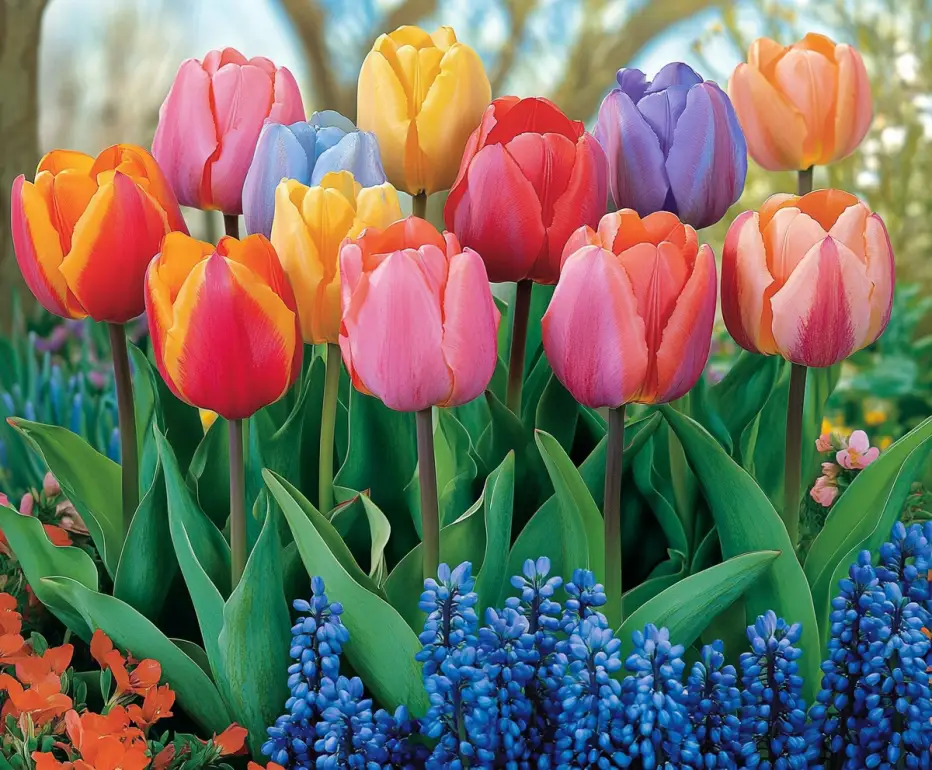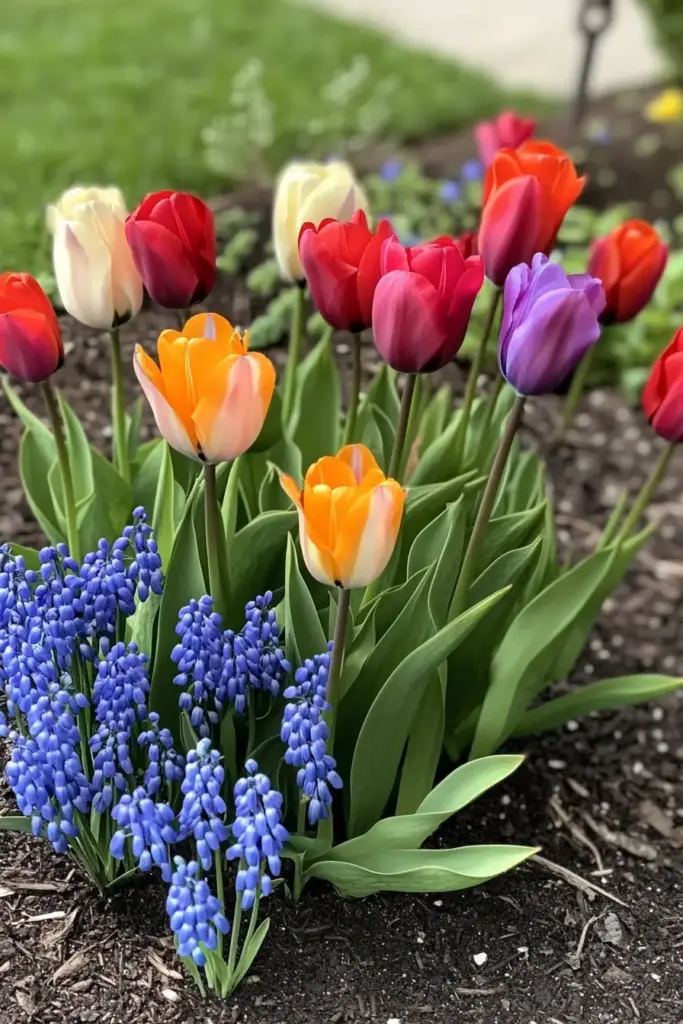Tulips are one of the earliest flowers to wake up your garden after a long winter, bringing vibrant color and the first true signs of spring. Their bold, cup-shaped blooms are beloved for good reason—they’re easy to plant, come in a stunning range of hues, and create striking displays whether in beds, borders, or containers.
In this guide, you’ll learn everything you need to know about planting and caring for tulips, from choosing the right bulbs to nurturing them season after season. Whether you’re a beginner or a seasoned gardener, these expert tips will help you enjoy a dazzling tulip show each spring.
🌼 Tulip Basics: A Springtime Icon
Native to parts of Central Europe and Western Asia, tulips have enchanted gardeners for centuries. Today, over 150 species and thousands of hybrid varieties are available, making it easy to find the perfect style and color for any garden.
What Makes Tulips Special?
- Come in almost every color imaginable
- Bloom early in spring, often before other plants wake up
- Grow well in containers, beds, or naturalized areas
- Bloom shapes vary: classic cup, ruffled, fringed, or star-shaped
- Range in height from 3 to 28 inches
While tulips typically bloom for only a week or two, their impact is unforgettable—and with the right care, you can enjoy them year after year.
🌿 Are Tulips Perennials or Annuals?
Botanically speaking, tulips are perennial bulbs, which means they’re naturally designed to bloom year after year. However, due to extensive hybridization over the centuries, most modern tulips don’t reliably return with the same vigor in future seasons.
So, Should You Treat Tulips as Annuals?
- In colder, mountainous regions (like parts of the western U.S.), tulips often perform more like true perennials. The gritty soil, cold winters, and dry summers mimic their native habitat, helping them rebloom for several years.
- In other climates, especially those with mild winters or damp soils, tulips tend to fade after their first or second bloom. For most gardeners, it’s best to treat tulips as annuals—planting fresh bulbs each fall for a spectacular spring show.
💡 Tip: Tulips are affordably priced and come prepped to flower in their first season, so even if they don’t come back, you’ll still get maximum beauty for minimal effort.
🌱 How to Plant Tulip Bulbs for Gorgeous Spring Blooms
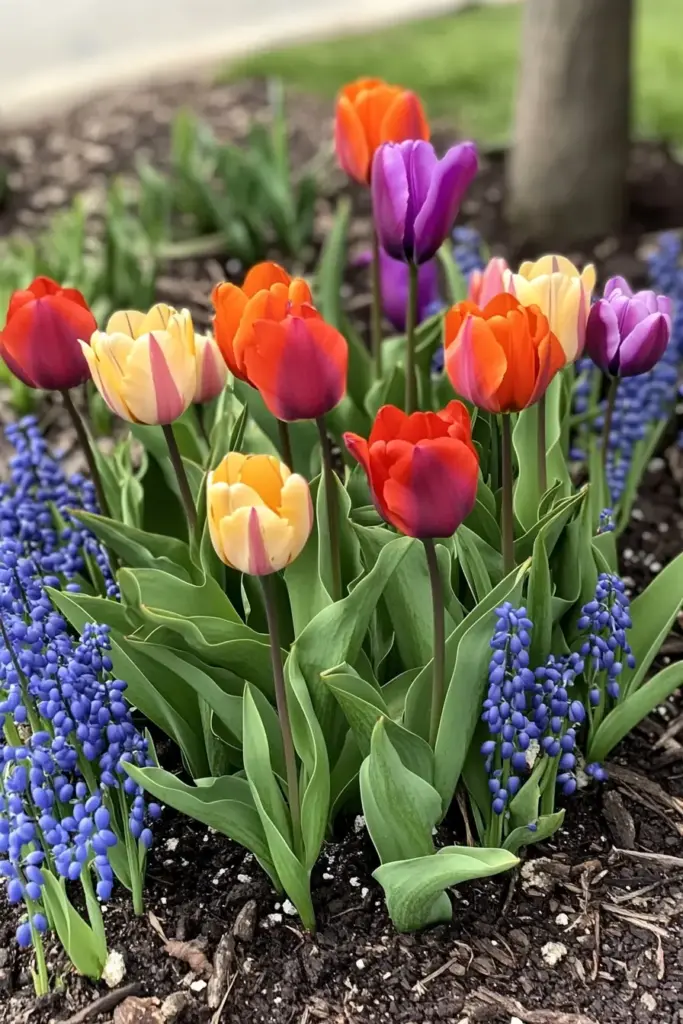
Planting tulips isn’t complicated, but doing it right can make the difference between a garden that pops with color and one that falls flat. Here’s your step-by-step guide to planting tulip bulbs the right way.
📅 When to Plant Tulip Bulbs
Timing is everything. Tulips need a cold period to trigger blooming—this process is called vernalization.
- In cooler climates (Zones 3–6): Plant bulbs in September or October, about 6–8 weeks before the first hard frost.
- In warmer climates (Zones 7–8): Wait until late November or December and use pre-chilled bulbs, since the soil doesn’t naturally stay cold enough.
Planting too early can lead to rot or disease; too late and the bulbs may not establish in time.
☀️ Where to Plant Tulips
Tulips love the sun—but not the heat.
- Best for most zones: Choose a spot with full sun or at least 6 hours of direct sunlight.
- For hot climates (Zones 7–8): Aim for a location with morning sun and afternoon shade to avoid overheating the bulbs.
🪨 Soil Prep: Drainage is Key
Tulips are prone to rot if left in soggy soil.
- Use well-draining, loose soil—avoid clay or compacted areas.
- If your garden soil is heavy, improve it by mixing in organic compost, sand, or leaf mold.
- Alternatively, plant in raised beds or containers with good drainage if your soil holds too much moisture.
🚫 Never plant tulips in consistently wet or heavy soils. Wet bulbs = dead bulbs.
⛏️ How Deep to Plant Tulip Bulbs
Depth and orientation matter:
- Depth: 6 to 8 inches below the soil surface
- Bulb position: Place bulbs pointy side up, roots down
- Cover with soil and press firmly to eliminate air pockets
📏 Spacing & Fertilization Tips
- Spacing: 4 to 6 inches apart to allow for airflow and growth
- Fertilizer:
- At planting, use a bulb-specific fertilizer or bone meal to encourage root development
- If you plan to grow tulips as perennials, feed again in early spring as leaves emerge
🌟 Pro Tip: Want that full, dramatic look? Cluster tulips in groups of 10–15 bulbs rather than spacing them out in single rows.
🌸 Caring for Tulips After Planting
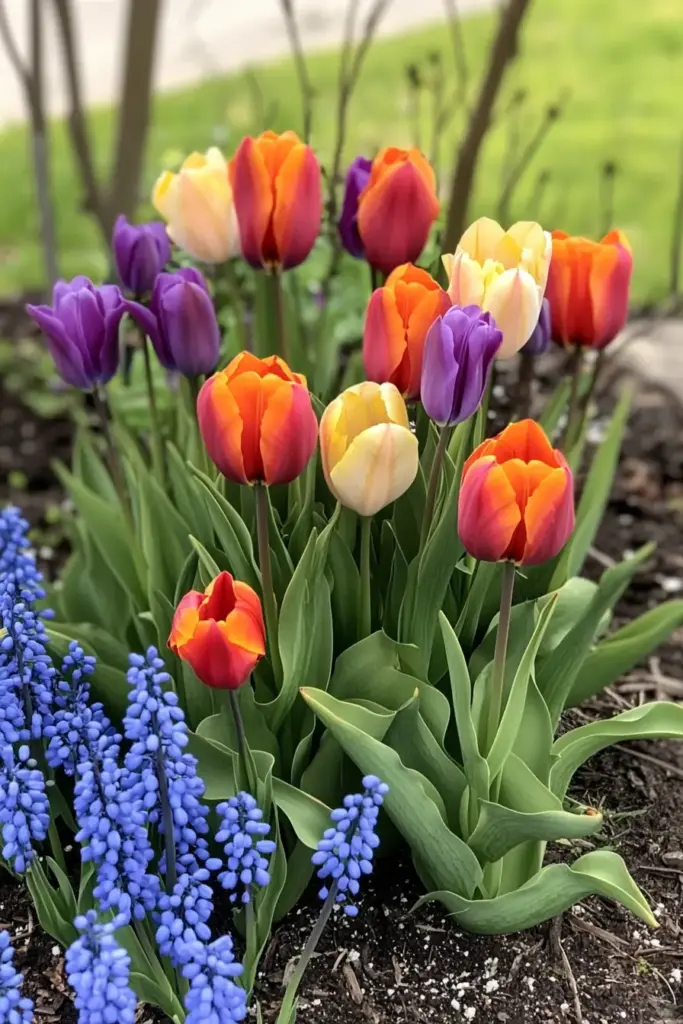
Tulips don’t ask for much, but giving them the right care can mean the difference between a decent display and a jaw-dropping spring showcase. Here’s how to nurture your tulips for healthy growth and repeat blooms (if you’re lucky!).
💧 Watering Tips
- Right after planting: Water once to help settle the soil around the bulbs.
- In fall and winter: If rainfall is regular, you don’t need to water at all.
- Dry spells: During extended dry weather, water lightly once a week until the ground freezes.
- Avoid soggy soil: Tulips hate sitting in water—overwatering leads to rot, not blooms.
🌧️ Remember: Less is more when it comes to watering tulips.
🌱 Fertilization Schedule
- Fall (at planting): Use bone meal or a slow-release bulb fertilizer to support root development.
- Early spring (when leaves emerge): Add another light feeding to boost flower production.
- Post-bloom care (if keeping bulbs): Mix in compost or bulb food to nourish bulbs for the next year.
❄️ Cold Climate Storage (If Needed)
In warm zones without consistent winter chills, your tulip bulbs may need a little help:
- After blooming, let the foliage die back naturally.
- Dig up the bulbs once the leaves turn yellow and dry.
- Store in a cool, dry place over summer.
- In early fall, refrigerate bulbs for 8–10 weeks (but not in the freezer or near fruits).
- Replant in late fall.
🧊 No cold = no blooms. If you’re in a warm region, pre-chilling is essential.
✂️ When to Cut Back Tulips
It’s tempting to tidy up your garden right after tulips bloom—but hold those shears!
🌼 Why You Shouldn’t Cut Tulip Leaves Too Soon
The leaves are doing important work after the flowers fade. They continue to photosynthesize, storing energy back into the bulb for next year’s growth. If you remove them too early, the bulb won’t have enough strength to bloom again.
🌿 Proper Cutback Timeline
- Let the foliage remain on the plant for at least 6 weeks after blooming ends.
- When the leaves turn yellow and dry, they’ve done their job—now you can trim them off at the base.
- Don’t braid or tie the leaves—this can limit their ability to absorb sunlight.
🧪 Pro tip: If you’re growing tulips in a bed with other plants, layer in perennials or groundcovers to camouflage the fading foliage while it dies back naturally.
🐛 Common Tulip Pests and Diseases (and How to Fight Back)
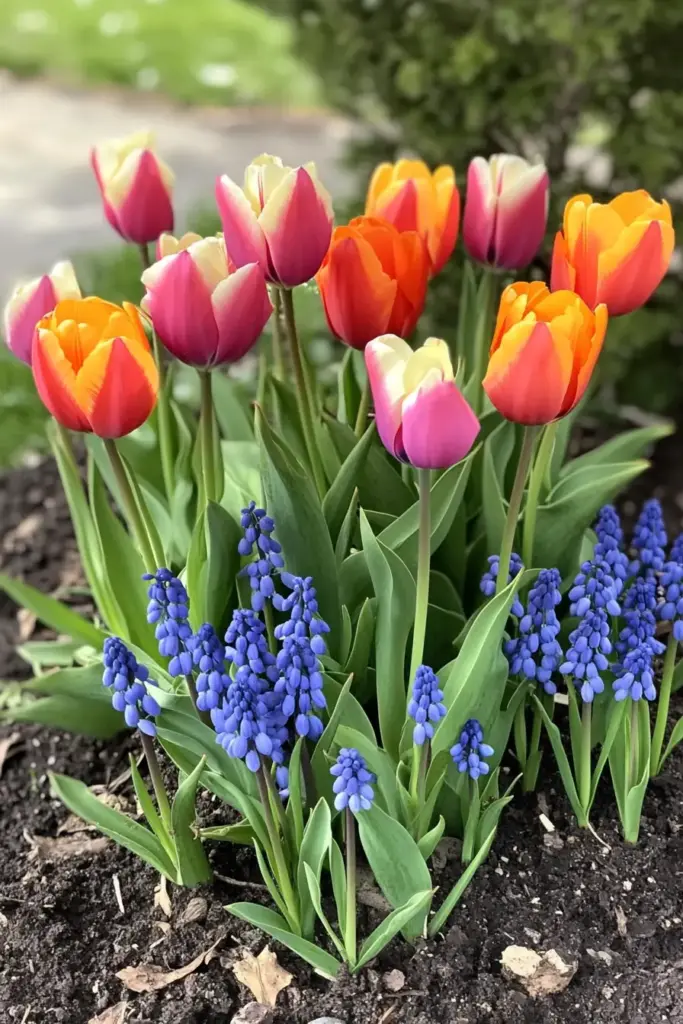
Even the healthiest tulip bed can face a few threats. Knowing what to watch for—and how to respond—can save your bulbs and blooms.
🦠 Fungal Diseases to Watch For
Tulips are especially vulnerable to fungal issues, especially in wet or poorly drained soil.
1. Basal Rot (Fusarium)
- Symptoms: Brown spots on roots, pink/white mold on bulbs, stunted or deformed flowers
- Fix: Discard affected bulbs, treat soil with a fungicide, improve drainage
2. Tulip Fire (Botrytis tulipae)
- Symptoms: Gray mold, twisted stems, spotting on flowers
- Fix: Remove and destroy infected plants, treat with fungicide, avoid overcrowding
3. Black Rot
- Symptoms: White fungal growth that turns bulbs soft; reddish or wilted leaves
- Fix: Remove infected bulbs, treat surrounding soil with fungicide, ensure soil drains well
🐞 Common Garden Pests
- Aphids: Suck sap, distort growth, can spread viruses
- Solution: Use insecticidal soap or neem oil
- Slugs & Snails: Eat emerging leaves and flowers
- Solution: Set beer traps, apply diatomaceous earth, hand-pick at dusk
- Nematodes: Microscopic worms that feed on roots and bulbs
- Solution: Rotate crops, solarize soil, plant nematode-resistant species
- Rodents & Deer: Tulip bulbs are a snack for squirrels, mice, and deer
- Solution: Use wire mesh baskets underground, apply repellents, or interplant with critter-resistant flowers like daffodils
⚠️ Healthy bulbs in well-drained soil are your best defense against most diseases.
🌟 Top Recommended Tulip Varieties
Whether you’re looking for dazzling annual displays or long-lasting perennial performers, there’s a tulip for every garden style and climate. Here’s a breakdown of the best options in both categories.
🌼 Best Tulips to Grow as Annuals
These varieties are known for their dramatic colors and bold presence—perfect for planting fresh each year.
- ‘Cracker Tulip’
A midspring showstopper with rich violet-purple blooms. Grows up to 20 inches tall and adds depth to any garden palette. - ‘Ile de France’
Classic red petals with strong stems—ideal for cut flowers or bold garden borders. - ‘Abu Hassan’
Deep mahogany-red petals edged in yellow-orange tones. Exotic and rich in contrast. - ‘Calgary’
Clean white blooms paired with blue-green foliage. A lovely option for crisp, modern gardens. - ‘Prinses Irene’
A real eye-catcher with fiery orange petals kissed by purple streaks. Blooms in late April. - ‘Ballerina’
This lily-flowered tulip has pointed orange petals and a sweet fragrance. Stunning in floral arrangements. - ‘Café Noir’
For a moodier vibe, this variety blooms in dark maroon-chocolate tones—very elegant for evening gardens.
🌷 Best Perennial Tulip Varieties (Reliable Rebloomers)
These tulips have a better chance of returning year after year, especially with proper care and the right climate.
🌱 Darwin Hybrid Tulips
Known for their large blooms, tall stems (up to 28 inches), and strong rebloom potential.
- ‘Acropolis’ – Red-pink blossoms with robust stems
- ‘American Dream’ – Huge yellow-red blooms, 6 inches across
- ‘Light and Dreamy’ – Soft sugar-pink petals with lavender centers
🌿 Botanical Tulips (Tulipa sylvestris)
Also called woodland tulips, these heirlooms naturalize well and thrive in wild or cottage gardens. Around 12 inches tall.
🌸 Clusiana Hybrids (Lady Tulips)
Petite and charming, these tulips are tough in dry or neglected areas. They top out at just 4–8 inches and bring a delicate touch to rock gardens or borders.
🌼 For best results, mix a few perennial types with showy annuals to enjoy both instant impact and longer-term rewards.
🌻 Conclusion: A Little Effort, a Lot of Spring Beauty
Planting tulips is one of the simplest ways to bring vibrant, joyful color to your spring garden. Whether you’re creating a container display on a patio or naturalizing a backyard bed, tulips reward a bit of fall effort with a burst of beauty when you need it most—right after winter’s chill.
Remember the keys to success:
- Choose healthy bulbs and plant at the right time
- Ensure excellent drainage
- Don’t overwater
- Let foliage die back naturally
- And if you’re in a warmer region—pre-chill your bulbs
From elegant single blooms to multi-colored hybrids, tulips offer something for every gardener. With this guide, you’re ready to grow a tulip display that turns heads and lifts spirits every spring.

